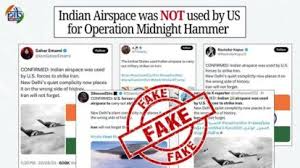India debunks social media claims that US used its airspace to launch strikes against Iran

Following the United States’ reported airstrike on Iranian nuclear sites, social media platforms flooded with misleading posts. One prominent claim alleged that the US used Indian airspace to carry out the operation. The Indian government quickly responded, rejecting the rumors as completely false.
On June 22, 2025, the Press Information Bureau (PIB) Fact Check team addressed the issue on X (formerly Twitter).
“A fake news is being circulated on social media claiming that US Air Force aircraft used Indian airspace to launch attacks on Iran. This claim is completely false. Indian airspace was not used by the United States during the reported military operation.”
The clarification followed multiple viral posts showing altered flight maps. These posts suggested India helped the US in “Operation Midnight Hammer,” a name linked to the attack on Iran. Many of the visuals used were either taken out of context or edited to mislead viewers.
India’s Firm Stand on Neutrality
India’s Ministry of External Affairs (MEA) issued a separate statement, making the country’s position clear. Officials said the government neither approved nor knew of any US military movement through Indian airspace.
An MEA spokesperson explained:
“India follows an independent foreign policy. No military aircraft entered our airspace in connection with any operation against Iran. No permissions were granted.”
The spokesperson emphasized that India continues to promote peace and diplomacy. New Delhi has long stood against involvement in regional conflicts and avoids taking sides.
US Clarifies Flight Path
At a press briefing, US General Dan Caine, Chairman of the Joint Chiefs of Staff, denied using Indian airspace. He said:
“We planned routes that avoided Indian airspace entirely. Our forces used international corridors and strategic deception to protect mission integrity.”
The Pentagon confirmed that aircraft launched from bases in the Mediterranean and the Arabian Sea. These included long-range bombers and naval units. Drones and satellite systems supported the operation, providing real-time intelligence.
Misinformation Spreads Online
Despite these official statements, conspiracy theories continued to spread across social media. Some users shared manipulated flight data and alleged radar tracking screenshots. These posts misled viewers by showing outdated or unrelated aircraft paths.
Fact-checkers quickly debunked the claims. They explained that the visuals did not match the operation’s timeline. Many screenshots came from commercial aircraft or unrelated military flights.
One independent fact-checking group noted:
- Flight data did not match the operation’s window
- Screenshots lacked verifiable timestamps
- Some accounts spreading the claims had shared false content in the past
Why This Matters
Spreading misinformation about India’s involvement in foreign conflicts can damage its international relationships. Iran remains a key energy partner for India. The US is also one of India’s strongest strategic allies. Misinformation could strain ties with both countries.
By issuing a swift denial, India protected its diplomatic balance. The government reaffirmed its long-standing position: non-intervention and neutrality in global conflicts.
Previous Cases of Disinformation
This isn’t the first time such misinformation has targeted India. Earlier this year, false reports claimed India allowed Israeli aircraft to refuel at Indian bases during attacks in Gaza. Officials debunked that claim as well.
Experts believe such narratives form part of larger disinformation campaigns. These efforts aim to create confusion and erode public trust in official communication.
Cybersecurity experts have warned about coordinated misinformation campaigns. These usually exploit sensitive geopolitical issues to stir public emotion and distrust.
The Role of Responsible Media
In the digital age, even false claims can reach millions within hours. That’s why timely government communication and fact-checking are critical. News consumers must also verify facts before sharing.
Experts advise readers to:
- Follow official government handles
- Use reliable news platforms
- Avoid spreading unverified visuals or claims
Conclusion
India has categorically denied the claim that US forces used its airspace to launch strikes on Iran. Both Indian and US officials have dismissed the allegations. Flight paths used in the operation did not pass over Indian territory.
Misinformation poses a growing threat to global diplomacy and public understanding. As this case shows, official sources and responsible journalism remain essential in countering false narratives.






